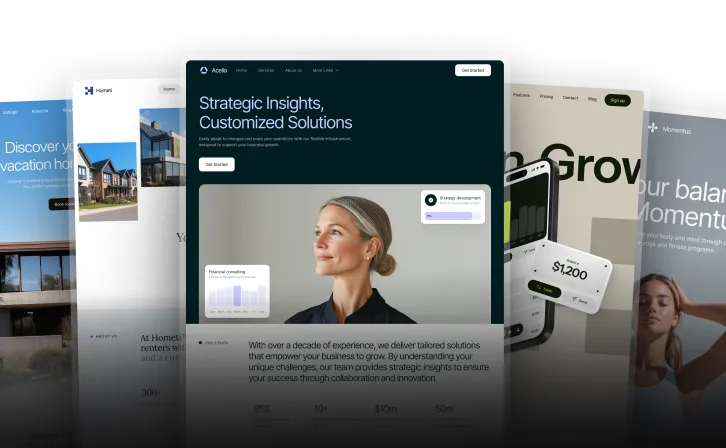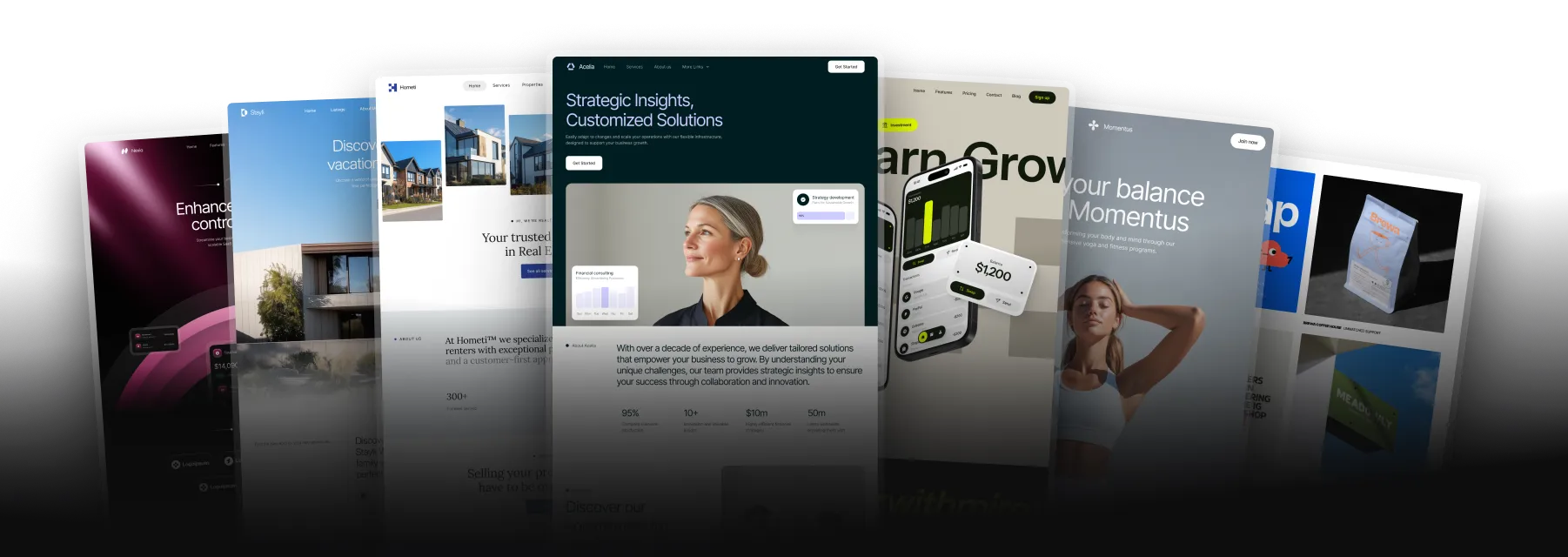Framer vs Wix: Which Website Builder is Right for You
Unlock all templates




Choosing between Framer and Wix depends on your needs:
- Framer: Best for designers and tech-savvy users who want advanced creative control and performance-focused websites. Starts at $5/month.
- Wix: Ideal for non-technical users and small businesses needing a quick, user-friendly setup with built-in business tools. Starts at $17/month.
Quick Comparison
| Feature | Framer | Wix |
|---|---|---|
| Design Control | Freeform canvas, advanced creative tools | Drag-and-drop editor, template-based |
| Target User | Designers, developers, creative agencies | Beginners, small businesses, content creators |
| Templates | 1,000+ templates and sections | 800+ templates |
| Performance | Optimized code, faster load times | Automated optimizations, global CDN |
| Mobile Design | Pixel-perfect control for mobile/desktop | Auto-optimized with mobile editing tools |
| Pricing | Starts at $5/month | Starts at $17/month |
| Key Strength | Advanced design flexibility | Ease of use, built-in business tools |
Key Takeaway: Use Framer if you prioritize design freedom and performance. Choose Wix for simplicity and fast setup without technical skills.
Core Features Compared
Interface and Learning Curve
Wix offers a straightforward drag-and-drop editor, making it ideal for users without technical skills. Its AI assistance simplifies the setup process even further. On the other hand, Framer's interface resembles tools like Figma and Sketch, catering to those who want more advanced creative control. These differences shape how each platform handles design flexibility.
Design and Layout Options
Both platforms leverage AI tools, but they approach design differently:
| Feature | Wix | Framer |
|---|---|---|
| Design Interface | Easy-to-use drag-and-drop editor | Figma-inspired tool with advanced options |
| Layout System | Structured sections, customizable | Grids, Stacks, and Auto-Layout |
| Design Import | Limited import capabilities | Seamless import from Figma or Sketch |
| Customization | Two-panel editor for global changes | Detailed control over every element |
| AI Assistance | Conversational AI for guidance | Text-based AI generation |
Available Templates
Templates play a key role in how users start their projects. Wix provides over 800 templates covering a variety of industries. Framer, however, offers more than 1,000 templates and sections tailored for businesses and SaaS products.
Mobile and Desktop Design
Wix automatically optimizes designs for mobile devices, with options for minor adjustments. Framer, in contrast, allows users to create pixel-perfect designs for both mobile and desktop, offering more precision for those who need it.
Framer vs Wix Review: Choosing the Best Website Builder

Best Uses and Users
Understanding the types of users for each platform can help pinpoint which one aligns with your website-building goals.
Who Should Use Framer
Framer is ideal for design pros and tech-savvy entrepreneurs who want full control over their website's look and feel. Its freeform canvas and advanced design tools are especially appealing to:
| User Type | Features They’ll Love |
|---|---|
| Web Designers | Interface similar to Figma/Sketch, advanced animations |
| Tech Startups | Scalable hosting, built-in SEO, high-performance layouts |
| Creative Agencies | Total design freedom, custom interactions, advanced features |
| Developers | HTML/CSS/JavaScript integration, deep customization options |
This platform shines for those ready to dive into its powerful tools and features.
"Framer gives you complete creative freedom to design, build, and publish stunning, responsive websites without Wix's drag-and-drop limitations, design constraints, or restrictive templates"
On the other hand, Wix focuses on simplicity and speed for users who need a website up and running quickly.
Who Should Use Wix
Wix is a go-to for small business owners, content creators, and entrepreneurs who want a professional-looking site without the hassle of coding or complex tools. Key user groups include:
| User Type | Features They’ll Love |
|---|---|
| Small Business Owners | Fast setup, built-in tools for managing businesses |
| Content Creators | Blog integration, media galleries for showcasing work |
| Service Providers | Appointment scheduling, client management features |
| Online Retailers | E-commerce tools, easy payment processing options |
Wix’s AI tools and templates make it simple to create a polished site without technical expertise.
"Wix is truly a beginner-friendly platform. Its drag-and-drop editor lets you add design elements like text boxes, images, buttons, and more directly onto a web page. It doesn't require coding, making it intuitive for anyone to understand."
Choosing between Framer and Wix depends on how comfortable you are with technical tools and your design goals. If you're after maximum creative flexibility and can dedicate time to learning, Framer is a strong option. For a fast, user-friendly setup, Wix is the way to go.
sbb-itb-fdf3c56
Technical Comparison
Page Load Times
Framer focuses on improving performance through targeted updates, while Wix leans on automation to streamline processes. Framer's updates deliver:
- Reduced JavaScript loading by up to 50%
- 5x faster optimization for larger sites
- 50% quicker interactivity
- 42% faster cookie banner display on mobile devices
Wix, on the other hand, uses a global Content Delivery Network (CDN) alongside features like automatic CSS/JS optimization, browser caching, and WebP image conversion to maintain fast load times.
"Wix always makes performance their priority and it definitely shows, both in monitoring tools and in their user's experience" – Yoav Weiss, Senior Software Engineer and Developer Advocate at Google
Next, let's see how both platforms manage the increasing demand for mobile optimization.
Mobile Performance
With mobile traffic accounting for roughly 60% of internet usage, both platforms prioritize mobile performance. Framer simplifies this by automatically converting images into AVIF or WebP formats. Wix goes a step further with dedicated mobile editing tools, allowing users to customize their mobile site layout and functionality.
| Feature | Framer | Wix |
|---|---|---|
| Image Optimization | Automatic AVIF/WebP conversion | Automatic WebP conversion |
| Video Handling | YouTube/Vimeo integration recommended | Built-in video player |
For optimal mobile performance, Framer users should confirm their site is set to "Optimized" in the settings. Wix users can take advantage of its mobile editing tools to fine-tune their site's look and speed.
Now, let's explore how both platforms handle security and hosting.
Security and Hosting
Both Framer and Wix rely on enterprise-grade infrastructure to ensure reliability and safety. Framer uses AWS with CloudFront and S3, while Wix operates across AWS, Google Cloud Platform, and Equinix.
Key security features include:
- Data Encryption: AES-256 encryption with TLS 1.2+
- Compliance: Adherence to ISO standards, SOC 2, and PCI DSS Level 1
- Environment Management: Separate production, staging, and development environments
- Security Tools: Application firewalls, bug bounty programs, and 24/7 monitoring
App and Tool Connections
Framer offers flexibility with tools for dynamic resource management, pre-rendering, and staging/versioning. Wix, in contrast, provides a more guided experience with built-in optimizations and secure integrations.
For best results, Wix users should keep image sizes under 8 MB and limit font types. Framer users should ensure their site is marked "Optimized" in the settings to maximize the platform's capabilities.
Cost Comparison
Pricing plays a key role in distinguishing these platforms after evaluating their technical features.
Framer Plans and Costs
Framer offers a range of pricing options, starting with a free plan and scaling up for personal and business needs.
| Plan Level | Monthly Cost | Key Features |
|---|---|---|
| Free | $0 | 1,000 monthly visitors, Framer banner |
| Mini | $5 | Custom domain, 2 pages, 1,000 visitors |
| Basic | $15 | 1,000 pages, 2 CMS collections, 10,000 visitors |
| Pro | $30 | 10,000 pages, 10 CMS collections, 200,000 visitors |
| Startup | $75 | 15,000 pages, 20 CMS collections, 6 editors |
| Scaleup | $200 | 30,000 pages, 30 CMS collections, custom proxy |
For business users, additional editors and locales cost $40 each. The Scaleup plan also includes advanced options like custom proxy setup, available for an extra $350 per month.
Wix Plans and Costs
Wix offers a variety of plans tailored for personal and business use, with built-in marketing and eCommerce tools.
| Plan Level | Monthly Cost | Storage | Key Features |
|---|---|---|---|
| Light | $17 | 2GB | Custom domain, 2 collaborators |
| Core | $29 | 50GB | Basic marketing suite, 5 collaborators |
| Business | $36 | 100GB | Standard eCommerce, 10 collaborators |
| Business Elite | $159 | Unlimited | Advanced marketing, 15 collaborators |
Additional Wix costs include:
- Domain renewal: $14.95/year after the first free year
- Premium apps: $2.50 to $499.90/month
- Payment processing fees: variable percentage plus a flat fee per transaction
- POS hardware: $1,495 for a complete package
These extras can add up, depending on your specific needs.
Price vs. Features by User Type
Choosing the right plan depends on your goals:
- Portfolios: Framer's $5 Mini plan is a budget-friendly option, while Wix's $17 Light plan offers more storage and collaboration features.
- Small Businesses: Framer's Basic plan ($15/month) is great for content management, but Wix's Core plan ($29/month) adds marketing and eCommerce tools.
- Growing Companies: Wix's Business plan ($36/month) suits online stores, while Framer's Pro plan ($30/month) works well for content-heavy sites.
For enterprise-level needs, both platforms provide custom solutions. Wix leans toward offering more built-in business tools, while Framer focuses heavily on design and content management.
Conclusion
Main Differences
Framer and Wix differ primarily in their approach to building websites. Framer focuses on giving users creative freedom with its freeform canvas, while Wix emphasizes ease of use with its structured templates.
| Aspect | Framer | Wix | Impact |
|---|---|---|---|
| Design Control | Freeform canvas | Template-based | Influences design freedom |
| Target User | Designers & tech-savvy users | Non-technical users & small businesses | Affects ease of use |
| Performance | Optimized code | Can be code-heavy | Impacts site speed |
| Starting Cost | $5/month | $17/month | Budget considerations |
These differences help define which platform is better suited for specific needs.
Making Your Choice
Go with Framer if you:
- Want full creative control over your website's design.
- Are comfortable using design tools like Figma.
- Need a marketing site that performs well.
- Want to create custom animations without coding.
- Plan to collaborate with a team on content management.
Choose Wix if you:
- Need to set up an e-commerce store quickly.
- Want access to a wide range of business tools.
- Prefer working with structured templates.
- Have little to no web design experience.
- Rely on advanced AI-powered features.
Wix appeals to a broader audience, offering a stable option for general business needs. On the other hand, Framer is tailored for creative professionals and brands looking to stand out with unique, visually striking designs.
Your decision should depend on your technical expertise, budget, and project goals. While Wix provides a more extensive feature set starting at $17/month, Framer's $5/month entry-level plan is a compelling option for those who prioritize design flexibility over built-in business tools.
Related Blog Posts
Recommended posts
Unlock all templates







